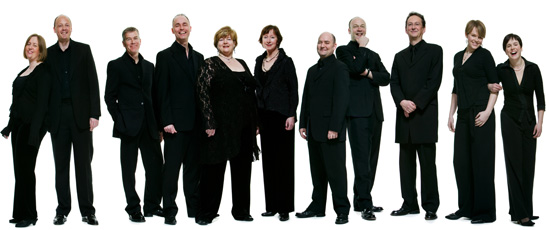Tallis Scholars magnify spirit of Christmas in a Renaissance concert at Rockefeller Chapel
 Review: Tallis Scholars at the University of Chicago’s Rockefeller Chapel. *****
Review: Tallis Scholars at the University of Chicago’s Rockefeller Chapel. *****
By Lawrence B. Johnson
For many music lovers, the single word Magnificat probably summons the name Bach, whose setting of this ancient “song of Mary” is doubtless the most famous to modern listeners. But in fact the Magnificat enjoys a long and glorious tradition in music history, notably in the 16th century, and several such Renaissance gems were on display Friday night in an exquisite concert by the Tallis Scholars at the University of Chicago’s Rockefeller Chapel.
 The ancient Magnificat canticle begins “Magnificat anima mea Dominum,” or “My soul doth magnify the Lord.” The speaker is the Virgin Mary, who expresses her amazement and humility that God has chosen her, “the lowliest of his handmaidens,” and marvels that “henceforth all generations shall call me blessed.” It would be hard to find a more perfect musical theme for Christmastide, and almost unimaginable to experience performances more luminous than the 10 singers under Peter Phillips delivered in the Rockefeller Chapel’s enveloping yet sharply focused acoustics.
The ancient Magnificat canticle begins “Magnificat anima mea Dominum,” or “My soul doth magnify the Lord.” The speaker is the Virgin Mary, who expresses her amazement and humility that God has chosen her, “the lowliest of his handmaidens,” and marvels that “henceforth all generations shall call me blessed.” It would be hard to find a more perfect musical theme for Christmastide, and almost unimaginable to experience performances more luminous than the 10 singers under Peter Phillips delivered in the Rockefeller Chapel’s enveloping yet sharply focused acoustics.
And yet one has come to expect nothing less from this British troupe, which has stood in the forefront of Renaissance ensembles since its founding by Phillips in 1973.
On this occasion, Phillips’ program included three Renaissance settings of the Magnificat – by John Taverner, Hieronymous Praetorius and Giovanni Pierluigi da Palestrina – as well as a contemporary version by Arvo Pärt. And among other 16th century paeans to the Virgin, by Robert White and Cristóbal de Morales, the choir interjected a further modernism from Benjamin Britten.
Taverner’s Magnificat for five voices, with its delicate textures and bright spirit, immediately established the all-around precision – of pitch, rhythm, timbre and enunciation – that Phillips draws from his carefully balanced ensemble. For pure jubilation, Praetorius’ Magnificat IV not only took the prize but also seemed to prefigure the Baroque music of jubilee one associates with Bach and Handel.
Both of those works profited from the chapel’s remarkably warm and clarifying acoustics. I couldn’t help but compare this experience with a Bach B minor Mass I heard a few years ago at Notre Dame Cathedral in Paris, where the vast acoustical space evoked heaven itself yet in that very quality lacked this immediacy and intimacy.
Palestrina’s Magnificat for double choir came last, and its multifaceted surfaces glistened like stained glass in full sunlight. Here Phillips’ singers sang of Mary’s transport and obeisance with such clarity that the text might have been English rather than Latin. And what a stunning contrast to the prevailing radiance of these Renaissance settings was Pärt’s lean, steely, almost laconic Magnificat, the voice of Mary transmuted from opulence to stark piety.
Yet there was splendor aplenty to be savored in the rich textures of Robert White’s “Tota pulchra es, amica mea” – “You are altogether beautiful, my beloved” – and the lush tapestry of Morales’ “Regina caeli.” Even the sleek musical profile of Britten’s “Hymn to the Virgin” elicited cool primary colors from this superb choir.
To set up the evening’s celebration, Phillips opened with the joyful Renaissance sound of Jan Pieterszoon Sweelinck’s “Hodie Christus natus est,” with its ecstatic line so prophetic of the event at hand: “Today on earth the angels sing.”
Related links:
- Tallis Scholars are currently on tour: Check their upcoming dates at the artists’ website
- Magnificat text: See Latin with parallel English translation
- Hear the Magnificat sung as Gregorian Chant: Go to YouTube
- The Tallis Scholars have made more than 50 recordings:Find the catalog at Gimell Records
- Sample some excerpts:Browse these Tallis videos on YouTube
Photo captions and credits: Home page and top: The Tallis Scholars with director Peter Phillips, third from right (photo by Eric Richmond). Left: Facsimile of a Renaissance illumination of Mary, with text in Latin from the Magnificat, from “Les Très Riches Heures du duc de Berry”
Tags: Arvo Part, Britten, Cristobal de Morales, Hieronymous Praetorius, John Taverner, Magnifcat, Palestrina, Peter Phillips, Robert White, Sweelinck, Tallis Scholars

